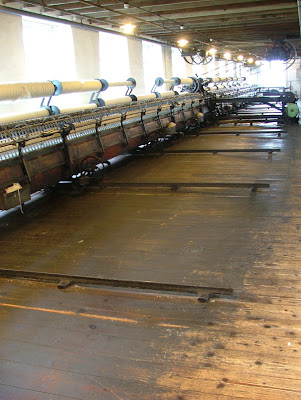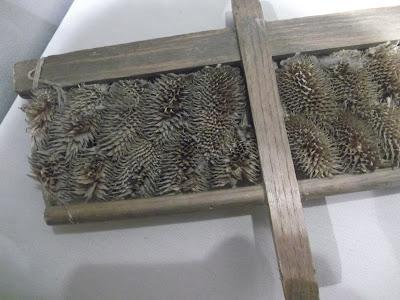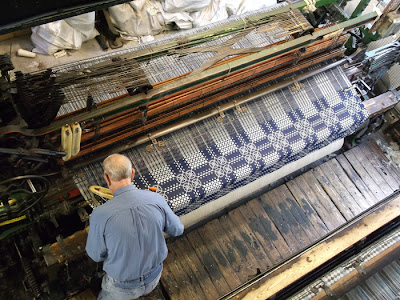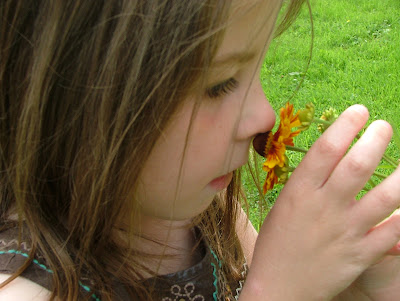National Wool Museum Wales
Well as promised in my holiday round-up post I am back to share more about the
National Wool Museum in Dre-Fach Felindre, Wales. The National Wool Museum re-opened in 2004 after a major refit partly funded my the heritage lottery fund and was previously the Museum of the Welsh Woollen Industry opened in 1976. Before becoming a museum it was a working woollen mill once powered by the water wheel you still see outside.
Previously known as Cambrian Mills opened in 1902 to supply woollen cloth for working men in the coal and steel industries. Later it produced flannel to be made into military uniforms. A fire in the carding and spinning department in 1919 meant that the mill was rebuilt, even though at the time the market for woollen textiles had reduced. It continued to be a working mill until 1965 when it was put up for sale.
So there is a brief history of the site of the museum, here is how it looks now and what you can see and learn from a visit. You arrive in the car park at the rear with a field of sheep grazing and some beds containing plants used in natural dyeing which would have been used many years ago in the mill. You cross a bridge over the river and enter the building into the cafe, shop and information area. We picked up a map and a children's activity card on the story of wool and set off on our adventure.
Story of Wool card
The museum is so well laid out, you get to see the process from raw washed wool through to woven fabric. We started with the processing of the wool and a machine called a Willower, first invented as a powered machine in the 18th Century and then manufactured in the 19th century - this disentangles wool and fluffs up the fibres ready for the carding machine.
Willower machine to fluff up and tease the wool
Wool goes in for the carding machine
The fluffy wool is then popped into the carding machine hopper that weighs the wool that it knows it can process and any excess falls out at the bottom to be used next time (very clever). Now this whole machine is just a marvel to watch, I was captivated by this machine - the first part of it cards it over many different drums and it comes out of there in a long smooth wide batt of real evenness. Onto the next part of the machine which brushes the batting down and separates it into thin grooves of perfectly even drafted threads of fibre that are wound onto the large "bobbins" - the machine creates 400 pencil thin roving threads ready to go up to the spinning room.
Carding wheels combing the wool smoothly and evenly
seperating carded fibre to thin pencil roving
pencil roving winding on the bobbins
They have a lift there now but back in the days of this being a working mill these would have been carried upstairs to the spinning machines. The spinning machines were called The Mighty Mule, and mighty they were. There were two sets of these machines taking up the whole of one side of the top floor - as a working mill this would have been mirrored on the other side of the room too.
roving ready to spin
Spinning Mule machinery runs along the room
Spun fibre winds up on the blue bobbins
Mesmerized again at the capacity of these machines to spin so much yarn in a fraction of the time I can spin, no wonder the industrial revolution put cottage industries of spinners out of business - progress eh! Still they are an absolute joy to watch spinning the roving prepared earlier as the machine moves apart and then as it returns when the correct amount of twist is in the yarn, it automatically winds onto the bobbins. The machine spins 400 yarns in one go! I took a video of this in action (and the carding machinery too, will try and upload them sometime). This would then go off to be plied and then off to the dyeing and weaving stages.
Yarn plying and winding
In the Mighty Mule room there are also some spinning wheels including the Walking Wheels also known as the Great Wheel, and other examples. There are also some weaving looms and knitting machines on display.
Walking Wheel or Great Wheel
Spinning Wheel photos by Imogen
(on her camera, and yes she discovered the B&W option)
Teasel Raising Gig
teasel hand carder
A machine that catches the eye is the Teasel Raising Gig. A machine invented in the 16th Century (and manufactured sometime in the 19th C) for finishing the cloth. An amazing sight, this one came from a nearby woollen mill. As its name suggests it uses teasels that comb the cloth to make it soft and fluffy, a process called "raising the nap". There are hand carders in the museum made with teasels as this was the method of carding before more modern hand carders were invented. The machine contained 3000 teasels in an iron frame and powered by electricity to pass the cloth over the teasels. It was replaced later with a Moser Raiser for which there is an example in the museum too, which uses metal teeth instead of teasels.
teasels lined up in the machine
A fascinating fact about the teasel gig was that there was a "teasel man" who travelled from mill to mill replacing teasels grown in specialist gardens in Somerset. It was a highly skilled job as the teasels needed to be carefully placed in the machine to give an evenness to the cloth.
Amongst other equipment and photos of the mill, the mill workers and the history of the area and knitting groups, etc there is a board with cards of memories of the mill which were a fascinating read.
Tenter Machine
Onto another room and another amazing machine - this one is the Tenter Machine (Moser Raiser). The damp cloth used to be stretched in a tenter frame and left to dry outside. Wind sheds protected the cloth outside. Along came the Tenter machine which dried the damp cloth under tension as it passed over steam heated pipes, it was capable of drying 72 metres of cloth at a time. A hut was built around the machine to keep the heat in - called a tenter box - this must have been a hot job to do in the mill.
Making up room, samples and sewing machine
Steam press
Folding machine
A visit to this museum really shows how clever some inventors were in the past, the machines they invented are just marvelous to see and must have really changed how things were made and prepared. The next room we entered was a making up room set up with samples, sewing machines and patterns to show how items of clothing were made up. Also inside is a Rolling and Folding Machine, invented in the 20th Century to help with finishing of the cloth. Another machine next to this is the Rotary steam press.
We moved along to the Weaving samples gallery - examples of clothing, national dress costumes, wedding dresses and examples of the woven cloth manufactured over the years. A delight to the eyes to see so many patterns. You often think of all the different patterns, tweeds and tartans of Scotland but obviously Wales has it's own history of these too which I wasn't really aware of.
Marriage record graffiti
Also in this room was a display highlighting some graffiti set into the window frame of mill workers who met and married in the 1930's and 1940's. They have left their mark in the graffiti of their names and when and where they married, a lovely piece of social history. Many pictures adorn the walls of the museum and examples of woven fabrics. There is a knitting group that meets in the cafe of the museum and they created this lovely wall hanging.
Knitting Group wall hanging - note the names around the side
blanket stitch
expert carder!
watching the man vs machine display on shearing
The story of wool activity card was a hit with Imogen. All around there were woolly tales posters to help with the answers to some statements. Also there are holes to keep samples of a carded rolag, some of the yarn, and the edges were set up to create some blanket stitch on it which Imogen mastered in no time. She also produced a pretty good rolag with the carders (although the wool samples for this weren't the best wool!). There is an arty crafty corner for the children to draw and colour, and have a go at weaving and woolly crafts. One of the displays compares the speed of hand shearing sheep to machine shearing, there are samples of Welsh breed wool to touch, and lots of other beautiful displays.
There are several weaving looms around the museum, but also next door is the working weaving studios where you can walk along the gallery above and watch the men and their machines working on cloth now. The day we visited they were making blanket fabric and flannel fabrics which is the fabric they are famous for making in the area. Wow it was noisy - it does say not to spend more than about 10 minutes in there! Amazing to watch the pattern appear and the speed of the shuttles was amazing (again I took a short video of this).
Weaving in action
Of course we came away with some samples. A flannel face cloth and a woven bookmark form Imogen, some fabric for a project for me and a beautiful shirt for Alex. I'll have to take some pictures of them and post them another time.
Beds of dye plants
A wonderful museum, I wasn't sure how long we would spend there but it turned out to be a lot longer and we all enjoyed it immensely. We'll be back sometime that's for sure.
























































